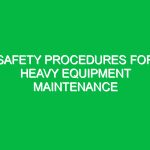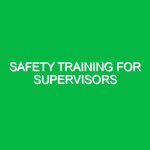In the world of automotive manufacturing, the phrase “safety first” transcends mere words; it embodies a culture that prioritizes the well-being of workers and the environment. Safety in automotive manufacturing refers to the practices, regulations, and technologies employed to protect employees from workplace hazards, mitigate risks, and ensure compliance with health, safety, and environmental (HSE) standards. As the automotive industry continues to evolve, with advancements in technology and methodologies, the importance of robust safety measures remains paramount.
The Relevance of Safety in Automotive Manufacturing
Automotive manufacturing is a complex process involving various intricate operations, from assembly lines to materials handling. Each stage of production presents unique challenges and risks. The relevance of safety in this sector cannot be overstated, as it directly impacts employee health, product quality, and the overall efficiency of manufacturing processes. A robust safety program not only mitigates the risk of accidents but also fosters a culture of responsibility and awareness among workers.
Identifying Hazards and Risks in Automotive Manufacturing
Understanding the potential hazards in automotive manufacturing is the first step toward effective safety management. The environment is rife with risks that can lead to severe injuries or even fatalities if not addressed properly. Here are some of the most common hazards:
1. Physical Hazards
Physical hazards include machinery and equipment-related risks. For instance, employees operating heavy machinery may face dangers such as crushing, pinching, or entanglement. Additionally, slips, trips, and falls are prevalent, often caused by cluttered workspaces or wet surfaces. According to a report from the National Safety Council, over 25,000 workplace slip and fall injuries occur annually in the manufacturing sector.
2. Chemical Hazards
The use of various chemicals in automotive manufacturing, such as paints, solvents, and adhesives, presents significant risks. Exposure can lead to respiratory issues, skin irritations, or even long-term health complications. Employees must be educated on the proper handling and storage of these substances to avoid accidents.
3. Ergonomic Hazards
Repetitive motions, awkward postures, and manual handling contribute to musculoskeletal disorders (MSDs). A study by the Bureau of Labor Statistics indicates that MSDs account for over 30% of workplace injuries in manufacturing. Implementing ergonomic solutions, such as adjustable workstations and mechanical aids, can significantly reduce these risks.
4. Noise Hazards
High noise levels are common in automotive manufacturing environments due to machinery and equipment operation. Prolonged exposure to loud environments can lead to hearing loss, making it crucial to implement noise control measures and provide personal protective equipment (PPE), like earplugs or earmuffs.
5. Electrical Hazards
Electrical risks are prevalent, especially when dealing with high-voltage equipment. Improper wiring, malfunctioning machinery, or failure to properly train employees can result in severe injuries or fatalities. Regular inspections and adherence to electrical safety standards are necessary to mitigate these risks.
Safety Precautions and Best Practices
With an understanding of potential hazards, the next step is to implement effective safety precautions and best practices. Here are actionable strategies to enhance safety in automotive manufacturing:
1. Training and Education
Regular training sessions are vital for educating employees about safety protocols and hazard recognition. Ensuring that all staff members are familiar with emergency procedures, the proper use of PPE, and safe machinery operation can drastically reduce the likelihood of accidents. For instance, a leading automotive manufacturer saw a 40% reduction in workplace injuries after implementing a comprehensive training program.
2. Risk Assessments
Conducting thorough risk assessments is essential to identify potential hazards and develop strategies to mitigate them. This process involves evaluating each work area, understanding the tasks performed, and determining the associated risks. Engaging employees in this process not only empowers them but also provides insights into potential hazards that management may overlook.
3. Implementing Engineering Controls
Engineering controls involve redesigning workspaces or machinery to reduce exposure to hazards. For example, installing machine guards can prevent workers from accessing dangerous moving parts. Additionally, investing in automated equipment can minimize manual handling tasks, thereby reducing ergonomic risks.
4. Regular Maintenance and Inspections
Adopting a proactive approach to maintenance ensures that machinery and equipment function safely. Regular inspections help identify potential issues before they lead to accidents. Establishing a checklist for routine checks can streamline the process and ensure compliance with safety standards.
5. Establishing a Safety Culture
Creating a culture of safety requires the commitment of all employees, from management to frontline workers. Encourage open communication regarding safety concerns, and recognize individuals who prioritize safe practices. When employees feel responsible for their safety and the safety of their colleagues, the likelihood of accidents diminishes.
Regulations and Standards Governing Safety in Automotive Manufacturing
Adhering to regulations and standards is critical for ensuring safety in automotive manufacturing. Various organizations and government agencies provide guidelines and frameworks for compliance:
1. Occupational Safety and Health Administration (OSHA)
OSHA sets and enforces standards to ensure safe working conditions across industries, including automotive manufacturing. Employers must comply with OSHA regulations, which cover everything from machinery safety to chemical handling and employee training. Regular inspections by OSHA can lead to penalties for non-compliance, emphasizing the need for vigilance.
2. ISO Standards
The International Organization for Standardization (ISO) provides various standards relevant to automotive manufacturing, including ISO 45001, which focuses on occupational health and safety management systems. Implementing ISO standards can help organizations systematically manage safety risks and improve overall safety performance.
3. National Fire Protection Association (NFPA)
In addition to OSHA standards, the NFPA offers guidelines for fire safety in manufacturing settings. Given the potential for fire hazards due to flammable materials, adherence to NFPA standards is crucial for ensuring the safety of employees and facilities.
Conclusion
Safety in automotive manufacturing is not just a regulatory requirement; it is a fundamental aspect of operational excellence. By recognizing potential hazards, implementing effective safety measures, and adhering to established regulations, manufacturers can create a safer work environment. As the industry continues to evolve, embracing a proactive approach to safety will not only protect workers but also enhance productivity and compliance. Ultimately, a commitment to safety benefits everyone involved—from the frontline workers to the end consumers, ensuring a responsible and sustainable automotive manufacturing process.


